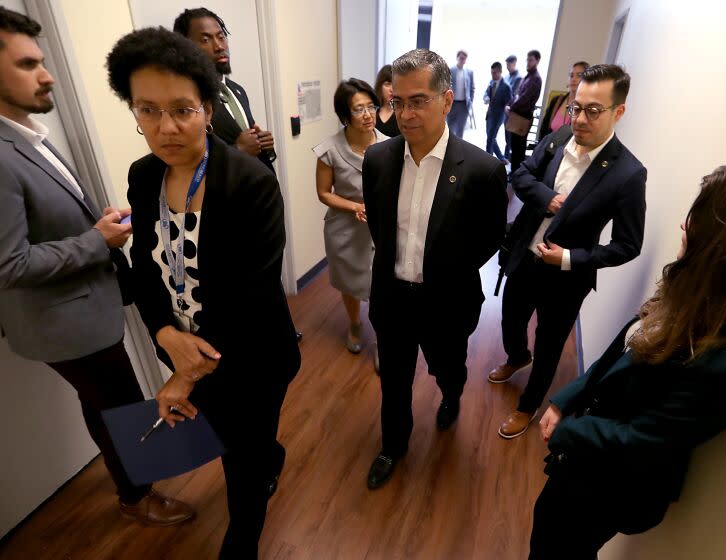Data, funding gaps threaten public health pandemic efforts

- Oops!Something went wrong.Please try again later.
Timely, comprehensive data and sufficient financial support are among the major resources necessary to prepare for future pandemics, a cadre of California public health officials said Thursday during a meeting with a top member of the Biden administration.
But in the post-emergency phase of COVID-19, both have become scarcer — a reality acknowledged by U.S. Health and Human Services Secretary Xavier Becerra.
"Without good data, it's like trying to dispense healthcare in the blind," he said during a discussion with leaders at the hospital, city, county and state levels.
The one-two punch of data and dollars is particularly vital to safeguarding public health, attendees of the Long Beach panel said. Data on how a disease is progressing or the sort of pressure it's exerting can inform how staff, equipment and other resources should be positioned.
And funding would ideally continue flowing both to support systems that proved their worth during the three-year-long pandemic and to tackle inadequacies it laid brutally bare.
"From a public health standpoint, I think we did learn a lot," Long Beach City Health Officer Dr. Anissa Davis said. "I think we learned what it takes to be able to respond. I think we learned that you can get out in the community and really rapidly respond, vaccinate, test, set up treatment."
But the recent end of emergency declarations that had been issued during COVID-19's early onset also has diminished some of the available resources.
Congress, which already had proved reluctant to authorize additional funds the Biden administration sought for COVID vaccinations and treatment, is also now moving to claw back billions in unused emergency relief funding as part of a federal debt limit deal.
Prior to the expiration of the federal public health emergency on May 11, HHS had authority to require lab test reporting for COVID-19. That's no longer the case, according to the department.
While many jurisdictions have entered into data-use arrangements with the U.S. Centers for Disease Control and Prevention, gaps remain.
Federal officials now no longer post weekly tallies of coronavirus cases or COVID-19 deaths. There is no longer a national percentage of coronavirus tests that are coming back positive.
Instead, the main metric posted by the CDC is hospitalization data. For the most recent week, there were 7,643 coronavirus-positive hospital admissions nationally, an 8.4% decrease from the prior week.
The outgoing CDC director, Dr. Rochelle Walensky, has similarly lamented the reduction in data gathering. Recently on Capitol Hill, she said the agency was losing some insight into the demographics of people seeking vaccines.
“We will make do,” Walensky said. “However, this should worry us all, primarily because [of] what it says about the visibility we will have into the next outbreak. We will be back to square one.”
The Los Angeles County Department of Public Health has said it is committed to the continued reporting of a "robust collection and monitoring of local COVID-19 information." While the CDC is continuing to regularly post national hospitalization figures, that data is a lagging indicator, and other sources of information will act as an early warning locally, the agency said.
L.A. County also is continuing to report weekly coronavirus cases and COVID-19 deaths, as well as coronavirus levels in wastewater. L.A. County reported 40 COVID-19 deaths for the week that ended Tuesday; weekly deaths here have been relatively low and consistent for months.
According to the most recent data, coronavirus levels in the county's wastewater were at a low level — 11% of the winter peak. That figure has been stable for weeks.
And 2% of hospital emergency room encounters are reported as being related to the coronavirus in L.A. County. Officials say there would be a high level of concern if that figure were greater than 10%.
While many healthcare systems in L.A. County and elsewhere are experiencing their most prolonged COVID reprieve, some say they're hard-pressed to keep up with the other needs of their communities. Staffing issues exacerbated by the pandemic have not vanished. And financial challenges remain an all-too-real concern — one that's pushed some hospitals to their breaking point, particularly in more rural areas.
Beyond COVID, there are numerous health issues facing Southern California. Other infectious diseases are continuing to circulate, not to mention the wider community struggles with mental health and substance abuse.
"A lot of what we're talking about for preparedness is not just for emergencies, it's just for general help in closing the gaps that we see and improving health for everybody," said Los Angeles County health officer Dr. Muntu Davis.
In an interview following the round-table discussion, Becerra acknowledged that "it's hard to convince people that you should invest in the long term," and even more so when you're asking people to focus on preventing a possibility, rather than confronting a reality.
"Bottom line, we do what we know we must with what we have, and we as a nation don't do as much as we should to prepare for what might come," he said.
This story originally appeared in Los Angeles Times.

